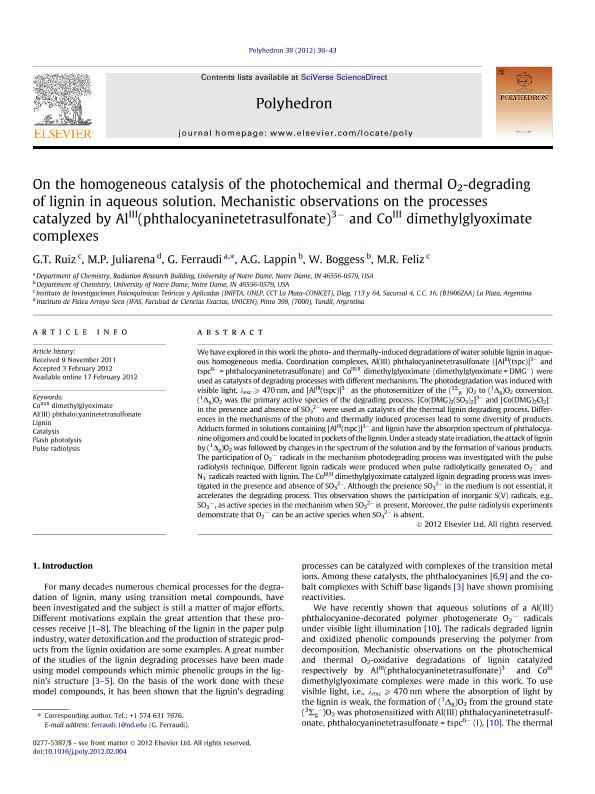Mostrar el registro sencillo del ítem
dc.contributor.author
Ruiz, Gustavo Teodosio

dc.contributor.author
Juliarena, María Paula

dc.contributor.author
Ferraudi, G. J.
dc.contributor.author
Lappin, A. G.
dc.contributor.author
Bogges,W.
dc.contributor.author
Feliz, Mario R.
dc.date.available
2019-08-20T21:16:22Z
dc.date.issued
2012-05
dc.identifier.citation
Ruiz, Gustavo Teodosio; Juliarena, María Paula; Ferraudi, G. J.; Lappin, A. G.; Bogges,W.; et al.; On the homogeneous catalysis of the photochemical and thermal O 2-degrading of lignin in aqueous solution. Mechanistic observations on the processes catalyzed by Al III(phthalocyaninetetrasulfonate) 3- and Co III dimethylglyoximate complexes; Pergamon-Elsevier Science Ltd; Polyhedron; 38; 1; 5-2012; 36-43
dc.identifier.issn
0277-5387
dc.identifier.uri
http://hdl.handle.net/11336/81884
dc.description.abstract
We have explored in this work the photo- and thermally-induced degradations of water soluble lignin in aqueous homogeneous media. Coordination complexes, Al(III) phthalocyaninetetrasulfonate ([Al III(tspc)] 3- and tspc 6- = phthalocyaninetetrasulfonate) and Co III/II dimethylglyoximate (dimethylglyoximate = DMG -) were used as catalysts of degrading processes with different mechanisms. The photodegradation was induced with visible light, λ exc ≥ 470 nm, and [Al III(tspc)] 3- as the photosensitizer of the ( 3Σ g -)O 2 to ( 1Δ g)O 2 conversion. ( 1Δ g)O 2 was the primary active species of the degrading process. [Co(DMG) 2(SO 3) 2] 3- and [Co(DMG) 2Cl 2] - in the presence and absence of SO 3 2- were used as catalysts of the thermal lignin degrading process. Differences in the mechanisms of the photo and thermally induced processes lead to some diversity of products. Adducts formed in solutions containing [Al III(tspc)] 3- and lignin have the absorption spectrum of phthalocyanine oligomers and could be located in pockets of the lignin. Under a steady state irradiation, the attack of lignin by ( 1Δ g)O 2 was followed by changes in the spectrum of the solution and by the formation of various products. The participation of O 2 ·- radicals in the mechanism photodegrading process was investigated with the pulse radiolysis technique. Different lignin radicals were produced when pulse radiolytically generated O 2 ·- and N 3 · radicals reacted with lignin. The Co III/II dimethylglyoximate catalyzed lignin degrading process was investigated in the presence and absence of SO 3 2-. Although the presence SO 3 2- in the medium is not essential, it accelerates the degrading process. This observation shows the participation of inorganic S(V) radicals, e.g., SO 3 ·-, as active species in the mechanism when SO 3 2- is present. Moreover, the pulse radiolysis experiments demonstrate that O 2 ·- can be an active species when SO 3 2- is absent.
dc.format
application/pdf
dc.language.iso
eng
dc.publisher
Pergamon-Elsevier Science Ltd

dc.rights
info:eu-repo/semantics/openAccess
dc.rights.uri
https://creativecommons.org/licenses/by-nc-nd/2.5/ar/
dc.subject
Al(Iii) Phthalocyaninetetrasulfonate
dc.subject
Catalysis
dc.subject
Co Iii/Ii Dimethylglyoximate
dc.subject
Flash Photolysis
dc.subject
Lignin
dc.subject
Pulse Radiolysis
dc.subject.classification
Físico-Química, Ciencia de los Polímeros, Electroquímica

dc.subject.classification
Ciencias Químicas

dc.subject.classification
CIENCIAS NATURALES Y EXACTAS

dc.title
On the homogeneous catalysis of the photochemical and thermal O 2-degrading of lignin in aqueous solution. Mechanistic observations on the processes catalyzed by Al III(phthalocyaninetetrasulfonate) 3- and Co III dimethylglyoximate complexes
dc.type
info:eu-repo/semantics/article
dc.type
info:ar-repo/semantics/artículo
dc.type
info:eu-repo/semantics/publishedVersion
dc.date.updated
2019-05-08T17:21:42Z
dc.journal.volume
38
dc.journal.number
1
dc.journal.pagination
36-43
dc.journal.pais
Países Bajos

dc.journal.ciudad
Amsterdam
dc.description.fil
Fil: Ruiz, Gustavo Teodosio. Consejo Nacional de Investigaciones Científicas y Técnicas. Centro Científico Tecnológico Conicet - La Plata. Instituto de Investigaciones Fisicoquímicas Teóricas y Aplicadas. Universidad Nacional de La Plata. Facultad de Ciencias Exactas. Instituto de Investigaciones Fisicoquímicas Teóricas y Aplicadas; Argentina
dc.description.fil
Fil: Juliarena, María Paula. Universidad Nacional del Centro de la Provincia de Buenos Aires. Facultad de Ciencias Exactas. Instituto de Fisica Arroyo Seco; Argentina
dc.description.fil
Fil: Ferraudi, G. J.. University of Notre Dame; Estados Unidos
dc.description.fil
Fil: Lappin, A. G.. University of Notre Dame; Estados Unidos
dc.description.fil
Fil: Bogges,W.. University of Notre Dame; Estados Unidos
dc.description.fil
Fil: Feliz, Mario R.. Consejo Nacional de Investigaciones Científicas y Técnicas. Centro Científico Tecnológico Conicet - La Plata. Instituto de Investigaciones Fisicoquímicas Teóricas y Aplicadas. Universidad Nacional de La Plata. Facultad de Ciencias Exactas. Instituto de Investigaciones Fisicoquímicas Teóricas y Aplicadas; Argentina
dc.journal.title
Polyhedron

dc.relation.alternativeid
info:eu-repo/semantics/altIdentifier/url/http://www.sciencedirect.com/science/article/pii/S0277538712000708
dc.relation.alternativeid
info:eu-repo/semantics/altIdentifier/doi/http://dx.doi.org/10.1016/j.poly.2012.02.004
Archivos asociados
